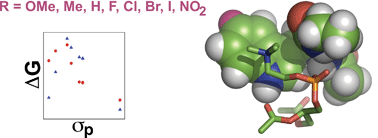Free-energy relationships for the interactions of tryptophan with phosphocholines†
Abstract
In U relationship as a function of the corresponding para-Hammett parameter, with

* Corresponding authors
a
Centre for Bioactive Chemistry, Department of Chemistry, University Science Laboratories, South Road, Durham, UK
E-mail:
j.m.sanderson@durham.ac.uk
Fax: +44 (0)191 3844737
Tel: +44 (0)191 3342107
In U relationship as a function of the corresponding para-Hammett parameter, with

 Please wait while we load your content...
Something went wrong. Try again?
Please wait while we load your content...
Something went wrong. Try again?
G. Blaser, J. M. Sanderson and M. R. Wilson, Org. Biomol. Chem., 2009, 7, 5119 DOI: 10.1039/B913919B
To request permission to reproduce material from this article, please go to the Copyright Clearance Center request page.
If you are an author contributing to an RSC publication, you do not need to request permission provided correct acknowledgement is given.
If you are the author of this article, you do not need to request permission to reproduce figures and diagrams provided correct acknowledgement is given. If you want to reproduce the whole article in a third-party publication (excluding your thesis/dissertation for which permission is not required) please go to the Copyright Clearance Center request page.
Read more about how to correctly acknowledge RSC content.
 Fetching data from CrossRef.
Fetching data from CrossRef.
This may take some time to load.
Loading related content
